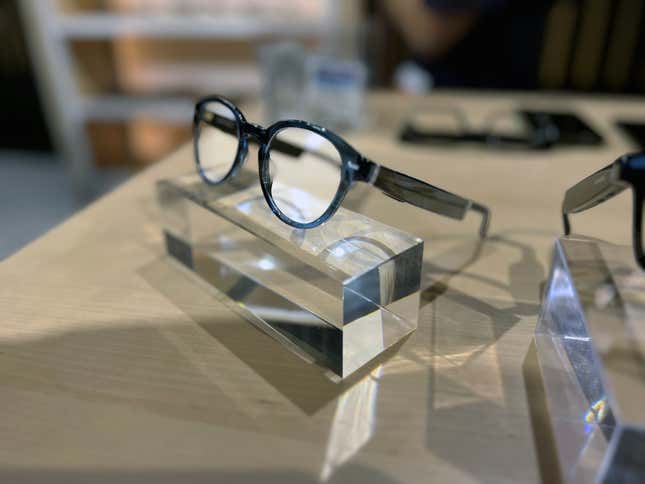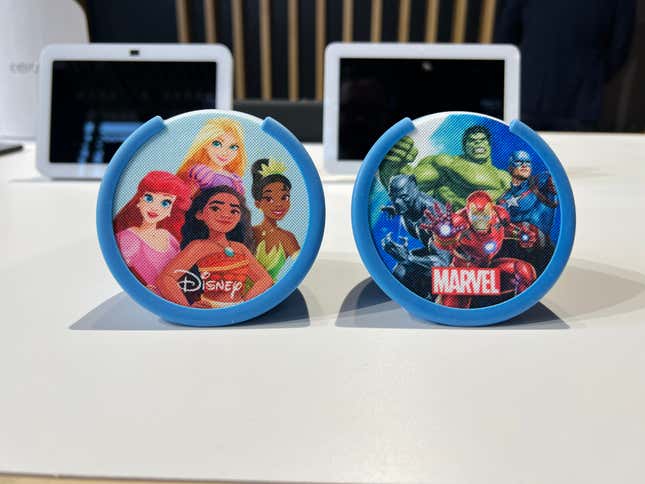At Amazon’s Fall Devices Event, the pressure was on to come up with a hit product that would stun the world the way Alexa and the Echo speaker did a decade ago. The event, held at Amazon’s HQ2 in Arlington, VA was Amazon’s first in-person event since before Covid and the first chance the company has had to have the tech press on hand for in-person demos of newly announced products.
Alexa and the Echo speaker line has been ubiquitous for a long time, mostly known for its ability to tell you the weather, play music on demand, and most importantly, turning lights on and off around your house. But other products, from Dash buttons to the Fire Phone, have been flops, and some potentially interesting inventions, like smart clocks and smart microwaves were greeted with a collective shrug. The idea of shopping by speech via Alexa has likewise never caught on, because it takes away your ability to comparison shop, study specs, or read customer reviews.
Advertisement
Worse, newer AI systems like ChatGPT and Google Bard make Alexa’s conversational skills feel positively primitive. Apple’s Siri has some of the same issues, feeling decidedly un-AI-ish compared to its newer competitors. From my personal experience, Alexa may work as it always did, but it certainly feels “dumber” lately, maybe because I’m used to the amazing capabilities of the latest AI models.
For this pre-holiday device launch, I hoped Amazon would show more than new versions of the Echo and Fire TV Stick.
Advertisement
Advertisement
Amazon exec David Limp jumped right in, talking about how Alexa was upgrading its generative AI abilities, studying what it takes to make “great AI,” using multiple sensors, from microphones to cameras to proximity sensors, to create a more realistic conversational experience.
The new Alexa showed off some of the same tricks we saw with ChatGPT last year, writing poems on demand or making recipe suggestions. More impressive was that you can now speak to Alexa without worrying that pausing for a second will time out the conversation. Amazon’s goal seems to be to make your relationship with Alexa less transactional, and to that effect, a conversation can continue over the course of many questions without saying the “Alexa” wake word again. But that also makes me worry about Alexa listening long after I want it to stop. You can manually cut off the conversation with a command at any time, but who’s going to remember to do that?
That said, adding what Amazon calls “Eye Gaze” on the Fire Max 11 tablet is a genuinely interesting concept, and picks up on the vision tracking that is powering the next generation of VR headsets, including the Apple Vision Pro and PSVR 2. That means you can select icons on the screen just by looking at them, and I think we’ll find eye tracking become more and more popular in the future.
Adding an Emergency Assist service for Echo devices is also interesting, allowing you to contact emergency services or an emergency contact on demand. It feels like a mix between the Apple Watch’s crash detection and the old Life Alert button hawked for years on TV commercials. But it also feels odd to charge for this basic service – it’s $6 a month or $60 for the year.
Advertisement

While Alexa may be improving, the event was also about devices. What we saw included new versions of the Echo Show smart screen/speaker, a new kids version of the low-cost Echo Pop, new kid-friendly versions of the Fire Tablet and reworked Echo Frames, smart-ish eyeglasses that can double as headphones. Adding a $120 smart soundbar, called the Fire TV Soundbar, is a good idea – anyone who uses the built-in speakers on their TV is really missing out.
Advertisement
The Fire TV hardware frankly already works great, there’s not a lot you can do with it until we all, say, jump from 4K content to 8K content. The new version, still called the Fire TV Stick 4K, adds better WiFi and a faster processor for $50. The Fire TV Stick 4K Max adds HDR and Dolby Atmos support for $60, and seems like the one you should get if you need a new streaming TV device.
That said, the demo of Alexa’s better AI for content discovery was more of a game-changer, allowing you to ask for suggestions based on movie genre, even using a vague description of an actor. “The actor who played the lawyer in Breaking Bad,” was the example used, bringing up Bob Odenkirk movies. Asking for movie results that I can watch with subscriptions I already have (aka, “free to me”) is handy.
Advertisement

There’s also some Dall-E-like generative AI art backgrounds you can slap on your TV, and you can run AI filters on photos to make new backgrounds. This isn’t especially new or even that useful, but adding it to Fire TV products makes it front-and-center for casual entertainment consumers.
Advertisement
In the end, the biggest surprise was a new map view you can use to control your smart home devices. You can map out where different smart lights or plugs are and control them visually from the Alexa app on your phone.
The new wall-mounted Echo Hub, which looks a lot like a small version of the Each Show 15, is another way to control all your smart bulbs and cameras, including cameras and Matter devices. For $180, it solves a problem we (and maybe Amazon) had created by mixing and matching so many different smart home device brands with conflicting standards and confusing setups.
Advertisement
But what this Amazon event was lacking was a breakthrough new hardware product, like the Astro robot from 2021. Nor did we get a new Kindle, even though my favorite Kindle, the high-end Oasis, hasn’t been updated since 2019. Instead, we got the promise of Large Language Model AI giving the decade-old Alexa assistant a modern makeover. Sorely needed, to be sure, but not as much fun as a new robot.
Services Marketplace – Listings, Bookings & Reviews